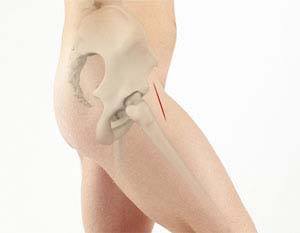Anterior Hip Replacement

What is Total Joint Replacement Surgery?
Total joint replacement surgery is one of the most advanced and successful procedures to treat severe hip and knee pain due to arthritis. Arthritis is a condition in which the articular cartilage that covers the joint surface is damaged or worn out causing pain and inflammation.
The goal of the surgery is to relieve pain and restore the normal functioning of the joint and help you resume normal activities.
What is Direct Anterior Approach Hip Replacement Surgery?
Direct anterior hip replacement is a minimally invasive hip surgery to replace the hip joint without cutting through any muscles or tendons. Traditional hip replacement involves cutting major muscles to access the hip joint.
Anterior Hip Replacement Procedure
Anterior hip replacement surgery is performed under general anesthesia or regional anesthesia. You will lie down on your back, on a special operating table that enables your surgeon to perform the surgery from the front of the hip. Your surgeon may use fluoroscopic imaging during the surgery to ensure the accuracy of component positioning and to minimize leg length inequality.
Your surgeon will make an incision, about 4 inches long on the front of the hip. The muscles are pushed aside to gain access to the joint and perform the replacement. Next, the femur is separated from the acetabular socket. The acetabular surface is prepared using a special instrument called a reamer. The acetabular component is cemented or fixed with screws into the socket. Then a liner made up of plastic, metal, or ceramic is placed inside the acetabular component.
The femoral head that is worn out is cut off and the femur is prepared using special instruments so that the new metal component fits the bone properly. Then, the new femoral component is inserted into the femur either by press fit or by using special bone cement. The femoral head component made of ceramic or metal is then placed on the femoral stem.
Once the artificial components are fixed in place, the instruments are withdrawn and incisions are closed with sutures and covered with a sterile dressing.
Risks and Complications of Anterior Hip Replacement
All surgeries carry an element of risk, whether it is related to the anesthesia or the procedure itself. Risks and complications with anterior hip replacement are rare, but can occur and may include:
- Infection at the incision site or joint space
- Fracture
- Nerve damage
- Hemarthrosis - excess bleeding into the joint after the surgery
- Deep vein thrombosis (blood clot)
- Leg length inequality
Post-operative Care for Anterior Hip Replacement
After traditional hip replacement surgery, you would be instructed to follow precautions to prevent your new hip from dislocating. These guidelines are very restrictive and include:
- No bending or flexing of the hip past 90 degrees.
- No crossing of legs.
- Use a pillow between the legs when sleeping.
- Use an elevated toilet seat.
With the anterior approach, your doctor will give you specific instructions to be followed at home for a faster recovery. These include:
- Take medications as prescribed to relieve pain and prevent infection.
- Participate in physical therapy to restore hip function and strength.
- Eat a healthy diet and do not smoke to facilitate healing and promote a faster recovery.
- Contact your doctor if you observe increasing swelling or redness in the operated area.
Advantages of Anterior Hip Replacement
The advantages of anterior hip replacement include:
- Smaller incisions
- Shorter operative time
- Minimal blood loss
- Short hospital stay
- Less postoperative pain
- Minimal soft-tissue trauma
- Less scarring
- Quicker recovery
- Early mobilization
- Less postoperative restrictions
- Quicker return to normal activities
- Lower risk of dislocation
Related Topics:
- Mini-Posterior Hip Replacement
- Hip Arthroscopy - Supine Position
- Robotic Total Hip Replacement
- Posterior Hip Replacement
- Hip Fracture ORIF
- Correction of a Failed Hip Replacement
- Correction of a Painful Hip Replacement
- Correction of a Loose Hip Replacement
- Hip Fracture Surgery
- Ischiofemoral Impingement Decompression - Procedure
- Surgical Release of Iliopsoas Tendon
- Physical Therapy for Hip
- Hip Arthroscopy
- Total Hip Replacement
- Minimally Invasive Total Hip Replacement
- Direct Anterior Total Hip Arthroptasty
- Revision Hip Replacement
- Computer-assisted Hip Replacement
- Gluteus Medius Tear
- Hip Trauma Reconstruction
- Slipped Capital Femoral Epiphysis
- AMIC of the Hip
- BMAC of the Hip
- Computer-Navigated Total Hip Replacement
- Direct Superior Hip Replacement
- Hip Reconstruction






